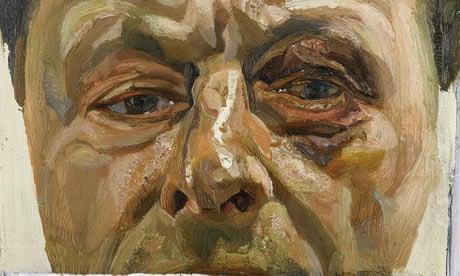For most people the aftermath of a punch in the face means a phone call to the police or a trip to A&E. But not Lucian Freud. His reaction to a nasty altercation with a taxi driver was to put the pain and anger aside and head to the studio to get his rather impressive black eye down on canvas.
Sotheby's today announced it is to auction a painting remarkable on many levels. Not only were the circumstances unusual, but the painting, Self-Portrait With a Black Eye, has been largely unknown to the art world for the past 30 years. It has never been recorded in the mountains of published literature on Freud and never publicly exhibited. Instead, it has remained in the same collection – private and European and from which four other Freud works will be sold – since it was painted in 1978.
The auction house believes the painting is the most important Freud self-portrait ever to come to market and estimates its value at up to £4m, expecting it to beat the £3.7m record for a Freud self-portrait set in 2005. It will probably not come close, however, to the record £17m reportedly paid by Roman Abramovich for Freud's 1995 painting Benefits Supervisor Sleeping.
Sotheby's expert Oliver Barker called the life-size portrait extraordinary. He said: "I first saw this picture several years ago and I was completely gobsmacked. It's not a big painting but its presence is just completely overpowering and shows Freud at the height of his powers."
The full circumstances of the altercation are not known but Barker said he would not be surprised if Freud had been goading the taxi driver – "they do normally have quite thick skins".
The man who originally bought the painting had been due to sit for Freud that day and was at Freud's studio when the artist arrived freshly bruised. He told his sitter to "go away", that he needed to paint himself there and then.
Freud, who was approaching 60 when it was painted, is known for his turbulent life in which violence has played a definite part. Talking about the role of Francis Bacon in his life he once said: "I used to have a lot of fights. It wasn't because I liked fighting, it was really just that people said things to me to which I felt the only reply was to hit them."
Barker said the immediacy of the newly discovered portrait was one of its most striking features. "Freud is very interested in the whole idea of paint mimicking flesh and this painting is not about flattery, it is about brutal, hard painterly reality."
That so little is known about the painting is testament to Freud himself, said Barker. He is an artist completely unbothered by self-publicity: he is "addicted to the act of painting".
According to Sotheby's, Freud – now 87 and in many eyes Britain's greatest living painter – has been to see the painting and enjoyed the experience, presumably rather more than he did in 1978.
The painting will be sold at Sotheby's on 10 February in a busy week of postwar and contemporary art sales in London. Aside from the Freud paintings, Sotheby's is selling works by Peter Doig, Piero Manzoni, Andy Warhol and Willem de Kooning as well as a huge Gerhard Richter oil painting, Abstraktes Bild. Highlights at Christie's include Yves Klein's Relief éponge or, estimated to be worth £5m to £7m, as well as works by Anish Kapoor, Martin Kippenberger and Frank Auerbach.
